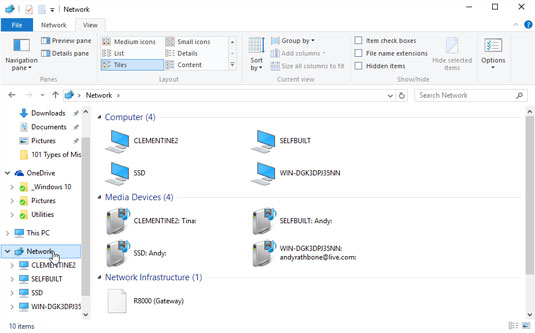Connecting a computer running Windows 10 to a network isn't very difficult, but you do need to make sure that your machine is properly connected and that your Homegroup is set up.
Connecting with cables
First, a word to the wired crowd: If you've chosen to connect a computer to your router with a cable, plug one end of the cable into your computer's network port. Plug the cable's other end into one of your router's network ports. (The ports are usually numbered; any number will do.)To connect other computers to the same router, connect cables between those computers' network ports and the router's other empty network ports.
If your internet company didn't do it for you, plug a cable from your broadband modem's LAN or ethernet port into your router's WAN port. (If your router and modem live together in one box, you can skip this step.)
Turn on your router, and you've finished: You've discovered how easy it is to create a wired network. (Be sure to set up a Homegroup, so your computers can begin sharing their files.)
Making a wireless connection
Wireless is a different story. After you set up your router to broadcast your network wirelessly, you must tell Windows how to receive it. Here's a quick how-to for connecting to your own network:-
Click the Start button and choose Settings from the Start menu.
-
When the Settings screen appears, click the Network & Internet icon.

Windows sniffs the airwaves and then lists all the wireless networks within range of your computer, including, with any luck, your own. (Your network will be the name — the SSID — that you chose when setting up your router, described in the previous section.)
The Network & Internet settings page, shown here, places the strongest available wireless networks at the top of the list.
 Windows sorts the available wireless networks, usually placing the one with the strongest at the top.
Windows sorts the available wireless networks, usually placing the one with the strongest at the top. -
Choose the desired wireless network by clicking its name and then clicking the Connect button.
If you select the adjacent Connect Automatically check box before clicking the Connect button, Windows automatically connects to that network the next time you're within range, sparing you from following all these steps again.
-
Enter a password and click Next.
Here's where you type in the same password you entered into your router when setting up your wireless network. (To confuse things, Windows 10 refers to your password as a "Network Security Key.")
If your router has a little button labelled WPS (Wi-Fi Protected Setup), you can press it at this point. The router then slips the password to your PC through the airwaves, sparing you from having to type it in.
At this step, Windows 10 offers to let you share a wireless network's password with all of your contacts. To do so, click the adjacent Share Network with My Contacts check box. This works fine for public networks, and for people with trustworthy friends. But if your contacts include some amusing but shady characters, don't check this box when connecting to your home network.
Solving connection problems
At this point, Windows 10 treats your newly joined wireless network as a public network, the same as one you'd find in a coffee shop or airport. You won't be able to find or access your other networked computers until you create a Homegroup.If you're still having problems connecting, try the following tips:
-
Cordless phones and microwave ovens interfere with wireless networks, oddly enough. Try to keep your cordless phone out of the same room as your wireless computer, and don't heat up that sandwich when web browsing.

-
From the Windows desktop, the taskbar's wireless network icon (shown in the margin) provides a handy way to connect wirelessly, as well. If your desktop's taskbar contains a wireless network icon, click it to jump to Step 3.
How to find other computers on a network
Windows 10 enables you to quickly find other computers on a network.Much of the time, you needn't care about the other PCs on your private network. But when you want to find a connected PC, perhaps to grab files from the PC in your family room, Windows is happy to help.
To find a PC on your Homegroup or traditional network, open any folder and click the word Network on the Navigation Pane along the folder's left edge, as shown here.






